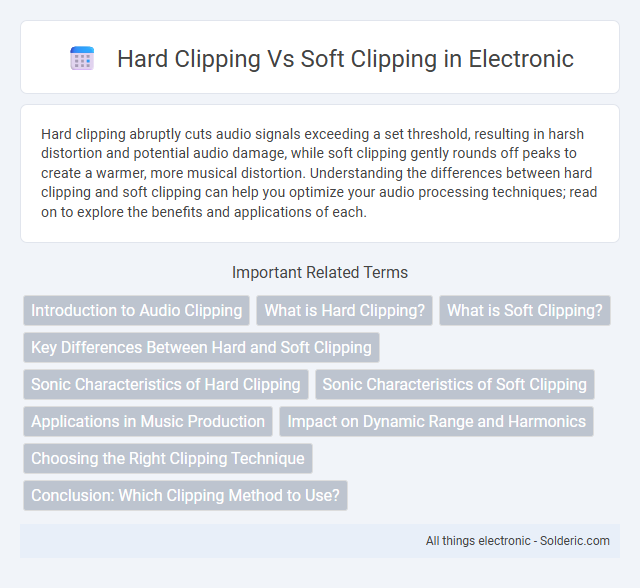Hard clipping abruptly cuts audio signals exceeding a set threshold, resulting in harsh distortion and potential audio damage, while soft clipping gently rounds off peaks to create a warmer, more musical distortion. Understanding the differences between hard clipping and soft clipping can help you optimize your audio processing techniques; read on to explore the benefits and applications of each.
Comparison Table
| Feature | Hard Clipping | Soft Clipping |
|---|---|---|
| Definition | Cuts waveform abruptly at a threshold | Gradually compresses signal near threshold |
| Sound Characteristic | Harsh, distorted, buzzy tone | Warm, smooth, musically pleasing distortion |
| Distortion Type | Severe waveform clipping | Non-linear compression |
| Use Cases | Special effects, aggressive distortion in rock/metal | Guitar amplifiers, vintage analog sound emulation |
| Harmonic Content | Rich in odd-order harmonics, harsh | Even-order harmonics, smoother timbre |
| Signal Integrity | Introduces abrupt waveform faults | Preserves more natural waveform shape |
| Implementation | Simple threshold limiter | Soft knee compression curve |
Introduction to Audio Clipping
Audio clipping occurs when an amplifier or audio device is pushed beyond its maximum capacity, causing distortion by cutting off the peaks of an audio signal. Hard clipping abruptly truncates the waveform, resulting in a harsh, aggressive distortion often heard in electric guitar effects and digital limiters. Soft clipping rounds off the peaks more gradually, producing a warmer, more natural sound that preserves some harmonic content and reduces listening fatigue.
What is Hard Clipping?
Hard clipping is a form of audio signal distortion where the amplitude of the waveform is abruptly limited to a specified threshold, causing the peaks to be "clipped" off sharply. This process introduces high-frequency harmonics and distortion, producing a harsh, aggressive sound that is commonly used in electric guitar amplification and certain types of audio processing. Hard clipping differs from soft clipping by creating a more pronounced and immediate cutoff, leading to a gritty and compressed tonal character.
What is Soft Clipping?
Soft clipping is a form of audio distortion that gradually rounds off the peaks of an audio signal, preserving more natural harmonics and reducing harshness compared to hard clipping. It operates by compressing the waveform smoothly as it approaches the clipping threshold, avoiding the abrupt cutoff characteristic of hard clipping. This results in a warmer, more musical distortion often preferred in guitar amplifiers and audio processing for maintaining sound quality while preventing digital overload.
Key Differences Between Hard and Soft Clipping
Hard clipping cuts audio signals sharply at a set threshold, creating a square waveform that introduces strong harmonic distortion and digital-like artifacts. Soft clipping gradually rounds off the waveform peaks beyond the threshold, producing smoother distortion with fewer harsh harmonics and more natural saturation. Key differences lie in the distortion character and sonic impact: hard clipping results in aggressive, buzzy sounds ideal for limiters, while soft clipping offers warmer, analog-style saturation favored in overdrive effects.
Sonic Characteristics of Hard Clipping
Hard clipping produces a distinct, aggressive distortion by sharply truncating audio peaks, resulting in a harsh, gritty sound with pronounced harmonic overtones and increased high-frequency content. This method generates odd harmonics that enhance perceived loudness and presence but can introduce digital artifacts and aliasing if not carefully managed. Ideal for genres seeking intense, edgy tones, hard clipping emphasizes transient impact and sonic aggression over warmth and smoothness.
Sonic Characteristics of Soft Clipping
Soft clipping produces a warmer, more natural distortion by gradually rounding waveform peaks instead of abruptly cutting them. It preserves harmonic content and adds subtle even-order harmonics, resulting in smoother, less harsh audio compared to hard clipping. This characteristic makes soft clipping ideal for musical applications where maintaining tonal richness and preventing digital harshness are essential.
Applications in Music Production
Hard clipping is commonly used in music production to create aggressive distortion effects, especially in genres like rock and electronic music, by abruptly cutting off audio peaks to produce a gritty, saturated sound. Soft clipping, favored for its smooth, warm distortion, is often applied in mastering and mixing to gently limit signal peaks without harsh artifacts, preserving the natural dynamics of your recordings. Understanding when to use hard versus soft clipping allows you to shape the tonal character of your tracks and maintain control over their loudness and clarity.
Impact on Dynamic Range and Harmonics
Hard clipping sharply cuts audio peaks, drastically reducing dynamic range and introducing high-order harmonic distortion, which can create a harsh, aggressive sound. Soft clipping, in contrast, gently compresses peaks, preserving more dynamic range and generating lower-order harmonics that produce a smoother, warmer tonal character. Understanding these differences helps you choose the clipping method that best suits your audio processing goals, balancing clarity and harmonic richness.
Choosing the Right Clipping Technique
Hard clipping produces a sharp distortion by abruptly cutting audio peaks at a set threshold, suitable for aggressive sound shaping or limiting, while soft clipping gently rounds peaks, preserving more of the natural dynamics and warmth of the signal. Your choice depends on the desired effect: hard clipping is ideal for extreme distortion in genres like metal or electronic music, whereas soft clipping maintains audio integrity for mastering and subtle saturation. Understanding the trade-offs in harmonic content and signal transparency helps you select the best technique to enhance audio quality and prevent unwanted artifacts.
Conclusion: Which Clipping Method to Use?
Hard clipping delivers a more aggressive distortion by sharply cutting off audio peaks, making it ideal for genres that require intense, gritty sounds like rock or metal. Soft clipping produces a smoother, warmer saturation by gradually rounding off peaks, preferred in genres demanding subtle harmonic enhancement such as jazz or blues. Choosing between hard and soft clipping depends on the desired tonal character and dynamic control within the mix.
Hard clipping vs Soft clipping Infographic

 solderic.com
solderic.com